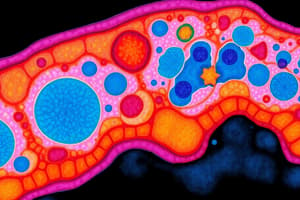Podcast
Questions and Answers
What are the three bases for the classification of epithelial tissues?
What are the three bases for the classification of epithelial tissues?
- Shape (correct)
- Number of layers of cells (correct)
- Location in the body
- Type of cell (correct)
What are the three distinctive shapes of epithelial cells?
What are the three distinctive shapes of epithelial cells?
Squamous, Cuboidal, Columnar
What are the two distinctive layers of epithelial cells?
What are the two distinctive layers of epithelial cells?
Simple, Stratified
Name two types of epithelial tissue.
Name two types of epithelial tissue.
What characterizes Simple Squamous epithelium?
What characterizes Simple Squamous epithelium?
What is a characteristic of Stratified Squamous epithelium?
What is a characteristic of Stratified Squamous epithelium?
What is the function of Transitional epithelium?
What is the function of Transitional epithelium?
What type of cells make up Simple Cuboidal Epithelium?
What type of cells make up Simple Cuboidal Epithelium?
What is the main function of Simple Columnar epithelium?
What is the main function of Simple Columnar epithelium?
Where is Ciliated Epithelium primarily found?
Where is Ciliated Epithelium primarily found?
Flashcards
Simple Squamous Epithelium
Simple Squamous Epithelium
A single layer of flat cells, found in areas where diffusion occurs like alveoli and capillaries.
Stratified Squamous Epithelium
Stratified Squamous Epithelium
Multiple layers of flat cells, with surface cells flattened and lower cells rounded. Found in skin, mouth, esophagus, and vagina.
Transitional Epithelium
Transitional Epithelium
A type of stratified epithelium where surface cells change shape from round to squamous, allowing for stretching. Found lining the urinary bladder.
Simple Cuboidal Epithelium
Simple Cuboidal Epithelium
Signup and view all the flashcards
Simple Columnar Epithelium
Simple Columnar Epithelium
Signup and view all the flashcards
Ciliated Epithelium
Ciliated Epithelium
Signup and view all the flashcards
What is a Simple Epithelium?
What is a Simple Epithelium?
Signup and view all the flashcards
What is a Stratified Epithelium?
What is a Stratified Epithelium?
Signup and view all the flashcards
What is Transitional Epithelium?
What is Transitional Epithelium?
Signup and view all the flashcards
What is Stratified Squamous Epithelium?
What is Stratified Squamous Epithelium?
Signup and view all the flashcards
Study Notes
Classification of Epithelial Tissues
- Epithelial tissues are classified by the type of cell, shape, and number of cell layers.
- Shapes of epithelial cells include:
- Squamous (flat)
- Cuboidal (cube-shaped)
- Columnar (tall and narrow)
Distinctive Layers of Epithelial Cells
- Simple epithelium consists of a single layer of cells.
- Stratified epithelium has multiple layers of cells.
Types of Epithelial Tissue
- Common types include:
- Simple Squamous
- Stratified Squamous
- Transitional
- Cuboidal
- Columnar
- Ciliated
Simple Squamous Epithelium
- Composed of a single layer of flat cells.
- Found in alveoli (for gas diffusion) and capillaries (for exchange of gases, nutrients, and waste).
- Smooth interior of capillaries is crucial for preventing blood clotting.
Stratified Squamous Epithelium
- Consists of many layers of flat cells; surface cells are flattened while lower cells are rounded.
- Forms the epidermis, which is keratinized due to keratin protein production.
- Lines oral cavity, esophagus, and vagina; surface cells are living, contributing to mucous membranes.
Transitional Epithelium
- Type of stratified epithelium where surface cells change shape from round to squamous.
- Lines the urinary bladder, allowing it to stretch as it fills without damage to the lining.
Simple Cuboidal Epithelium
- Made of a single layer of cube-shaped cells.
- Forms functional units of the thyroid and salivary glands, where it secretes hormones and saliva, respectively.
- Also present in kidney tubules, aiding in the reabsorption of valuable materials.
Simple Columnar Epithelium
- Features one layer of column-shaped cells, specialized for secretion and absorption.
- The stomach lining secretes gastric juices, while the small intestine lining absorbs digestion products.
- Microvilli increase surface area for efficient absorption in the small intestine.
Ciliated Epithelium
- One layer of column-shaped cells equipped with cilia on free surfaces.
- Lines respiratory tracts (nasal cavities, larynx, trachea) to sweep away mucus and debris.
- In the fallopian tubes, cilia help transport the ovum toward the uterus.
Studying That Suits You
Use AI to generate personalized quizzes and flashcards to suit your learning preferences.




